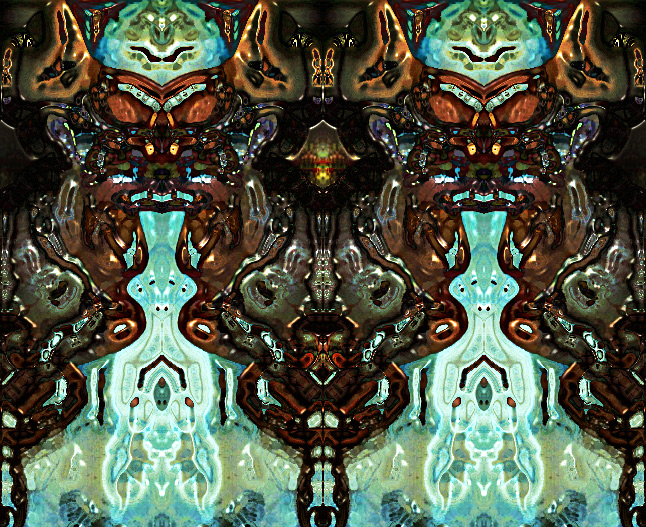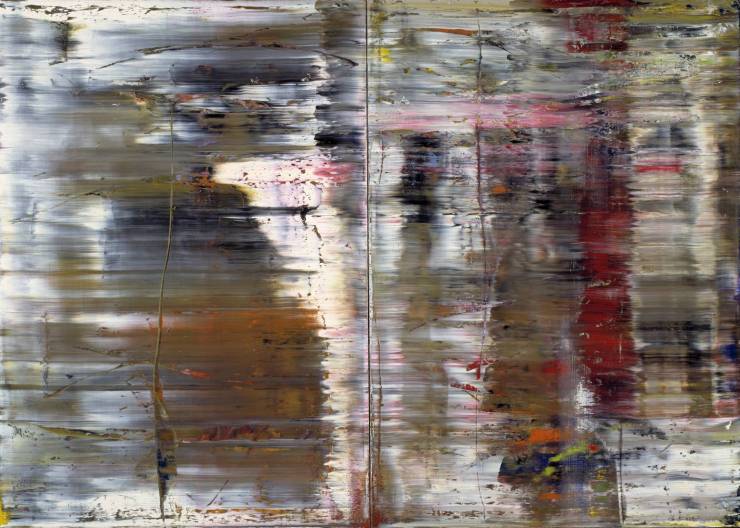I’m a big fan of Richter, especially his squeegee abstractions done with oil paint, and I bought a couple of his books, but his digitally created “Stripe Paintings” are trite, and a technique I figured out at least 15 years ago. When I saw them a few weeks ago for the first time, they reminded me of some early digital experiments I did, which I didn’t think were of sufficient interest to even share.
Here he is in front of one of these high-priced masterpieces:
 My early examples are lost or in one of my old computers collecting dust in someone’s basement, if it still exists at all. Initially I used this technique in combo with HTML to make a changing painting, for what that’s worth. And here’s a piece using the same essential technique I just knocked out in 3 minutes and 13 seconds, most of which was devoted to looking in my files for a source image to use.
My early examples are lost or in one of my old computers collecting dust in someone’s basement, if it still exists at all. Initially I used this technique in combo with HTML to make a changing painting, for what that’s worth. And here’s a piece using the same essential technique I just knocked out in 3 minutes and 13 seconds, most of which was devoted to looking in my files for a source image to use.
 I even like mine better. His is garish. Further, I could write a an “action” and apply it to a batch of images to create hundreds of these in minutes.
I even like mine better. His is garish. Further, I could write a an “action” and apply it to a batch of images to create hundreds of these in minutes.

Yuck. I don’t really even like this one. The way you do it is just make a selection of a photo or whatever, about 1 pixel wide, and then stretch it. DONE! Call it a day and open a new bank account, if you’re Gerhard Richter.
Take a good look at this original Richter:

Let’s see if I can do something quite similar in a matter of minutes.

The thing that’s weird to me about this is when I first discovered this technique I didn’t think it was in and of itself worth calling art, partly because it was way too easy to produce, but also because it was just horizontal stripes. Now it is blue-chip, vanguard, high art worth hundreds of thousands of dollars a pop because of the visionary brilliance of the famous artist. OK.
There’s just not enough in horizontal stripe paintings for my tastes. Gotta’ do something more with it. Instead I gather he made hundreds of these things. And the people fawned. Oh how they did. And they bought.
Here’s 15 more by me. Right. there are 16. One is by Richter. Can you guess which one?
Okay, okay, in the image at the top of the post with him in it, and the one below, you can see he uses a lot more thin lines than I did.

True, but, that might just be a matter of preference, and the one above features another one of my versions with an art critic hastily pasted on top. There are lots of variations one can do without much effort.
He did some other more complex things, but, I gather artists who start playing around with Photoshop (or program of choice) evolve through some of the same experiments that will naturally occur to one. It’s called “parallel development”, for what that’s worth.

Uuuuh. Yuuuuup. Again, I did similar things but didn’t think they were worth including in my portfolio. This involves a lot of mirroring images, flipping them, overlapping them, and other fun with layers and your basic editing tools.

Not, I thought, much better than psychedelic wall paper.

I made the one above a bit later, focusing on the sort of Surrealist imagery, but soon lost interest in this sort of art making. There was some promise in it, but the symmetry thing strikes me as a cop-out.
Don’t get me wrong. I’m not criticizing experimental digital art. I’ve written two articles defending it, A Defense of Digital Painting (and digital art in general), and, more recently Against Competitiveness in Art, and a Defense of Digital Art. True, I consider some things that I tinkered with myself more than a decade ago a bit slight, especially when heralded as museum-worth, contemporary art. But I see digital art as having enormous potential beyond rudimentary experiments.
I’ve had to deal with a lot of people completely dismissing my art, no matter what I do, because I use a computer. My point, is that digital art isn’t taken seriously as fine art until a big name artist does it, blows up the results to astronomical proportions, and makes them physical objects to buy, or more importantly, sell. Even stuff I don’t take seriously becomes uber-serious when the likes of Gerhard Richter does it.
As I said, I only recently discovered Richter’s dreary digital works, but am really impressed by his abstractions with paint and painting over photos. Those pieces are marvelous and gorgeous, the one below for instance:

Also, I don’t really know who came up with the “stretch a pixel wide column” technique first, me, or him, or hundreds or thousands of other people F’ing around with Photoshop. What surprises me is how uninteresting were his results, and how the art world took them so seriously.
The gallery below are some more abstract digital experiments I did much later, in February of 2014, using only text. They are vector images, which means they can be printed out as large as possible (they are math rather than pixels). Had they been done by Richter, they’d be marveled at and selling for hundreds of thousands, but I haven’t even bothered to include them in my portfolio, because I didn’t think there was enough going on, though I probably should, I guess.
Relatedly, I just saw some new works by Cindy Sherman, where she’s digitally manipulated them. I think a lot of digital artists, or fine artists who have dabbled in using the computer, look at those and think she’s blown away by her new discovery that you can use a liquify filter or something, but for us this shit’s oooooooold. And some of David Hockney’s digital paintings are grotesquely amateurish. These famous artists were slow to work with digital art, and they are treated like they are breaking new ground, when they appear to me to just be getting off the ground, or merely taxiing in the runway.
~ Ends
























Eric,
I like Richter too. His squeegee paintings are by far his best, but he has been doing them for a lot of years now. He’s become proficient at it, but I imagine it gets boring doing the same thing over and over. I get tired of doing the same style after a few months. Maybe that’s just me, maybe a lot of painters really enjoy doing their signature style over and over, day after day, month after month, year after year, then die. Sounds a lot like a job to me. I hope he has another change of style in him before he dies. I’m sure it would be great, he just needs to force himself out of his comfort zone. Maybe even throw away the squeegee.
LikeLiked by 1 person
Right, he’s an experimenter. True, I’m not at all impressed with his digital experiments, which, since I did virtually the same experiments, I consider making a huge mountain out of an ant hill. But, he’s always been interesting (aside from those works, which are a bit better than Hirst’s dot paintings, but that’s it), and he might have another trick or two or three left in him. Let’s hope so.
LikeLike
I read this somewhere lately ”Art beings at the end of your comfort zone”. Mr Richter would benefit….
LikeLiked by 1 person
That’s an intresting notion and goes directly agaisnt the notion that art should look good on a wall in the living room, which I detest. Are you saying Richter needs to take his art further out of the comfort zone?
LikeLike
YES, like he did in the older days. 🙂
LikeLike
art begins not beings
LikeLike
I find your criticism of Richter harsh. While I do agree with some points on the formulaic-ness of some of his abstractions in general the “I could have done that argument” to me is to simple (especially applied to abstract art). In particular your examples of the same techniques could be more refined visually and conceptually through iteration. My favorite take on the stripe process/slit scan photo is Tom Friedman’s take on it https://www.metmuseum.org/toah/images/hb/hb_1999.230.jpg which is stronger conceptually.
LikeLiked by 1 person
It’s not just “I could have done that” but rather I have done that, could do it again and did for the article within minutes, and could write an action (a.k.a. “macro?”) to produces hundreds or thousands of these in minutes.
And, no, my examples of the same technique are only less refined if you believe they are because you want to believe they are. In fact they are better. I could easily make them more “refined” by spending more than the absolute minimum number of seconds on them, though for your eyes I might need to find a way to make them look precisely like Richter’s, which might take a wee bit of tinkering. Personally, I prefer more subtle gradations of color.
Richter has abstract pieces which, as I said in the article, I greatly admire. I bought at least one book of his abstract paintings, and marveled at others in person in museums. But this series is drivel on par with Hirst’s spot paintings.
LikeLike